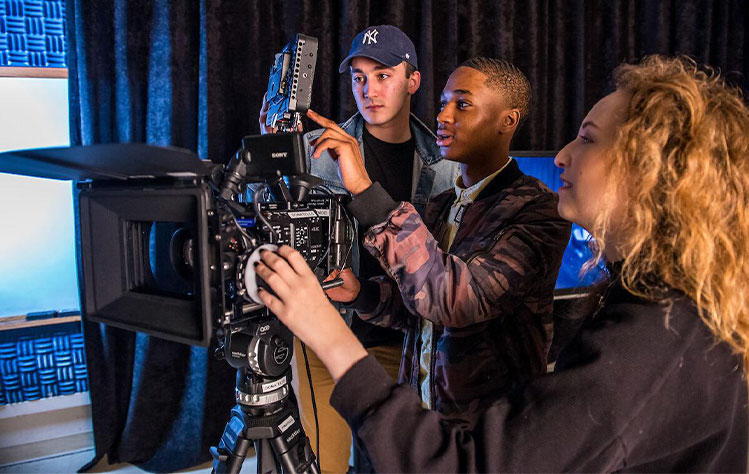Webster University is Preparing the Next Generation of Highly Skilled Media and Communications Professionals
November 10, 2021

Floating floors and suspended ceilings prevent sound from traveling while recording is in session. An LED wall in the sound studio allows for virtual video production. A multimedia studio equipped with the latest technologies enables students to learn and work on client-student projects across mediums such as newspapers, podcasts, video, animation, video game design and digital advertising campaigns.
These are just a few of the cutting-edge technologies and facilities available to students at Webster University’s School of Communications, which boasts innovative academic degree programs.
In 2021, online magazine Animation Career Review ranked Webster’s game design and animation programs among the best programs in the Midwest. Webster animation graduates, for instance, have gone on to work for major film and television studios.
It’s a privilege to have all of this technology at my disposal.”
Upgrades to the Multimedia Facility Are In Progress
To stay current, Webster is overhauling its facilities. Webster completed the first phase of the redesign in 2018 — a 16,600-square-foot portion of the 64,000-square-foot Sverdrup Building. Once the redesign of the School of Communications interiors and upgrades to the equipment are completed, some as soon as 2022, students will have at their disposal a multimedia facility on par with any real-world digital agency, news operation or production house.
Students Get Real-World Experience, Professional Development
Each program in the School of Communications requires students to conduct an internship so they gain working knowledge in their chosen fields.
Additionally, students get hands-on learning with professional grade equipment and project-based classes with real clients, budgets and deadlines.
Students also prepare for work in the real world through direct interactions with media professionals. Webster's School of Communications hosts an annual “Media Academy” featuring workshops, industry speakers and a student showcase.
Through innovative programs and state-of-the-art facilities, Webster's talented School of Communications faculty, staff, and students stand ready to meet that need.”
Webster is the place to be for young talent. Harrison Wong, a senior majoring in film, television and video production at Webster University, agrees.
“All this new innovation gives me a sense of purpose. I come here every day, even when I don’t have to be here, because it excites me and it feels like home,” said Wong. “It’s a privilege to have all of this technology at my disposal.”
Communications and media have become an essential part of every corporation, government and nonprofit. “We have corporate and community partnerships that provide scholarships to help diversify the talent pool of storytellers,” said School of Communications Dean Eric Rothenbuhler. “There are more jobs in this area than ever before. More highly skilled graduates are needed as a result.”
To meet this demand, Webster is developing a diverse pool of students so more voices and underrepresented groups can enter the industry.
“Webster wants to be the first-choice university for women and minorities majoring in communications,” Rothenbuhler said. “We have corporate partnerships that provide scholarships to help diversify the talent pool of storytellers.”
Webster’s President Julian Z. Schuster added, “The communications industry, including television, film, gaming and beyond, are a white-male dominated business. Our communications programs students are 50% female and over 30% are people of color. Webster graduates are highly skilled and are contributing to a needed shift in the industry that will be more representative of the population.”
The new Sverdrup Building will help move the School of Communications into the future by providing students a place to create and produce new media and modes of communications. In addition, the new Sverdrup Building will serve as the venue for hosting visitors, special events in support of partnerships with industry professionals, and community members.
A Global Education System
Webster has a robust study-abroad program with campuses in Asia, Europe and West Africa. For example, the School of Communications partnered with the Ministry of Education in Uzbekistan, in Central Asia.
“We know the global demand for highly-skilled professionals is growing not only in the U.S., but also in every one of the nine countries that are home to Webster campuses and locations. Through innovative programs and state-of-the-art facilities, Webster's talented School of Communications faculty, staff and students stand ready to meet that need,” said the school’s Chancellor Elizabeth “Beth” J. Stroble.
